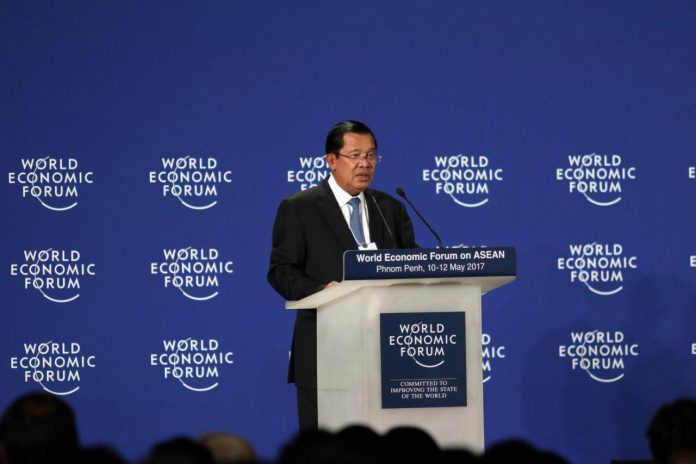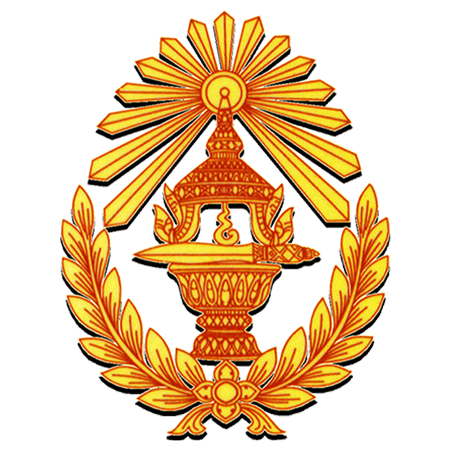- Excellencies Heads of State/Government, Ministers and Delegates,
- Excellencies, Ladies and Gentlemen, Distinguished National and International Guests,
- All Participants of the forum!
Cambodia is extremely honored to be a host of this World Economic Forum on ASEAN, under the theme: “Youth, Technology and Growth: Securing ASEAN’s Digital and Demographic Dividends”. On behalf of the Royal Government (RGC) and People of Cambodia, I would like to extend our warmest welcome to Your Excellencies, Heads of States/Governments, Ministers and Delegates, and all the Distinguished Guests who have come to this ancient land of ASEAN.
Indeed, this event is happening along the celebration of the 50th Anniversary of ASEAN establishment that provides an excellent platform for all national, regional and international stakeholders to discuss and exchange views on emerging trends related to three important topics: ASEAN and changing global context, ASEAN’s economic connectivity and ASEAN’s youth dividend. These topics are the deciding factors of ASEAN’s future development. I am delighted to note that this forum has brought together so many policy-makers, CEOs of multinational corporations (MNCs), businessmen, and youths from all walks of life both within and outside the region. This reflects great attention given to ASEAN as a whole, and particularly to Cambodia. Therefore, I believe that our discussion will be vigorous and realistic in providing policy choices, and implementable measures and practical projects for the long- term interests of ASEAN.
- Excellencies, Ladies and Gentlemen!
Over the past five decades, ASEAN has undergone a complex transformation since its founding, from a region with two blocs wracked by conflict, misery, and poverty to a region of peace, stability and development, and a closely integrated community, under a shared vision of “ASEAN Community”, characterized by high economic growth and deep structural transformation. Moreover, ASEAN has been positively responding to the resolution of all issues, both at regional and global levels, particularly in contributing to peace, security, safety and stability for all nations in both Asia and the world. All these are the contributing factors making ASEAN an indispensable strategic partner for other regions, other countries, regional and international organizations across the globe.
Undoubtedly, the newly changing global contexts, in all aspects of recent geo-political, geo-economic and politico-social developments such as the rising anti-globalization movement and protectionism, rising nationalism and populist policies, rising temperature in conflicts across some regions combined with a prolonged economic slowdown, have generated many new challenges for our national and regional development. Notwith-standing of these and in comparison to other regions, ASEAN has managed to maintain strong peace and security with good cooperation. While some other regional integrations in the world is experiencing a setback, ASEAN is forging ahead, with even stronger determination, its path for deeper integration in building ASEAN community, which is based on 3 pillars: political-security community, economic community and socio-cultural community, and through greater collaboration in all areas with our major partners. Though ASEAN is a regional grouping of 10 different countries, her past experiences and efforts in building this community, based on mutual respect, non-interference in other internal affairs, and consensus and flexibility in decision making for everyone to contribute to the development of ASEAN known as the “ASEAN WAY”, have shown strengths and fundamentals of ASEAN’s resiliency over the long run. On this basis, we will be forging ahead together in carrying out our tasks with unwavering commitment toward a unified goal of building ASEAN community with one identity: “ASEAN Unity in Diversity”.
- Excellencies, Ladies and Gentlemen!
Nowadays, ASEAN is the third largest economy in Asia and the seventh in the world, with total GDP of about USD 2.6 trillion in 2016. ASEAN has become one of the world’s fastest growing investment destinations, accounting for 11% of total global foreign direct investment (FDI) inflows as compared with just 5% in 2007. Moreover, ASEAN has also become one of the most attractive tourist destinations, both cultural tourism and natural tourism, with good security and high-standard hospitality.
Looking forward, ASEAN has envisaged ambitious vision in building ASEAN Economic Community 2025, which is a very highly integrated and cohesive economy, with four key characteristics including: 1st – a single market and production base, 2nd – a highly competitive economic region, 3rd – a region of equitable economic development and 4th – a region fully integrated into the global economy.
To achieve this vision, I believe ASEAN has to continue its focus on important agenda as follows:
1st – Continue strengthening and expanding cooperation to ensure full peace, security, safety and stability through promoting a close dialogue, building trust as well as resolving regional issues with peace and based on the principles of international law.
2nd – Continue ensuring that economic growth is robust, balanced, sustainable and inclusive with great attention given to reducing development gaps.
3rd – Continue ensuring successful implementation of “Master Plan on ASEAN Connectivity 2025” in every aspects including physical connectivity, institutional connectivity and people-to-people connectivity, aiming to promote competitiveness, development, inclusiveness and economic resilience in the region.
4th – Continue promoting ASEAN Centrality in regional cooperation and strengthening ASEAN capacity in resolving any problems at regional and global level. Thus, the first priority of ASEAN is to reach the conclusion of “Regional Comprehensive Economic Partnerships (RCEP)”, comprising of 16 countries with ASEAN as the backbone, which has a market size of 3.4 trillion people and GDP of USD 22.4 trillion or about 30% of the world’s economy in 2015.
Additionally, we also have to ensure that the adopted growth vision and agenda can effectively respond to the new context of rapid changing world, especially the strong momentum of the Fourth Industrial Revolution which creates a new growth dynamism characterized by high flexibility, dependence on technology and markets, yet at the same time, could create obstacles and challenges to the society including political and security, economic and socio-cultural aspect, at both national and regional levels.
Without a doubt, this new technological revolution will reset development for industry, trade, labour market and education, as well as governance and social security system, which require ASEAN to come up with appropriate policy response in order to support the process of structural change enhanced by this revolution. In this regard, ASEAN must have an integrated agenda aligning to this trend in order to seize the opportunity and to address unexpected problems by devoting great attention to promoting quality of education, promoting skill development, addressing employment issues, formulating an effective social protection system as well as addressing the issue of social inequality and cyber security etc.
As a responsible member, Cambodia is well-prepared to work with all stakeholders to undertake tasks aiming to achieve the “ASEAN Community Vision 2025: Forging Ahead Together” for long-term peace, security, stability and prosperity for all nations in the region.
- Excellencies, Ladies and Gentlemen!
Cambodia is a small economy with high level of openness. This is a prime reason that we have attached great importance to regional integration and connectivity. As a result, Cambodia’s economy is regarded as one of new emerging economies as well as one of the most successful post-war countries, which is based on robust economic growth on average of about 7.6% per annum from 1994 to 2016 and has maintained macroeconomic stability, attained manageable inflation, well-manage public debt, achieved remarkable poverty reduction as well as increased GDP per capita 4.5 time, from USD 288 in 2000 to USD1,302 in 2016. Indeed, trade has played a crucial role toward development of Cambodia’s economy. Becoming a member of ASEAN community and World Trade Organization has promoted Cambodia’s linkages with regional and global value chains and production networks. For the medium-term, Cambodia’s economic growth is forecast to be robust with growth around 7% per annum. In order to achieve its long-term vision, becoming upper middle income country by 2030 and high income country by 2050, Cambodia will unwaveringly and actively continue implementing open economic policy through devoting a greater deal of efforts on linking and integrating of all sectors into regional and global economy, speeding up structural reforms as well as to upgrading institutional capacity and human resources.
Moving forward, Cambodia is envisaging a trend of technology advancement. Similar to other countries in the region, Cambodia is rapidly absorbing advance technology, particularly in new industry sector and among youths. In 2016, mobile phone penetration was more than 125% of total population and internet penetration was 47% while in 2008 mobile phone penetration was only 25% and internet penetration was merely 0.13%. The new era of technology is an opportunity for Cambodian youths to speed up development with greater momentum. In this context, the RGC has been paying great attention on youth and technology development, especially though the reform of education system and training with great focus on promoting skill development in science, technology, engineer and maths (STEM) as well as promoting entrepreneurship and soft skills for life long training. Moreover, Industrial Development Policy 2015-2025 has re-oriented our efforts and open for private sector engagement with an aim of supporting technology sector development in Cambodia. In this spirit, I appeal to all business people to join hands with the RGC to create a favourable environment for nurturing and developing this potential sector. Cambodia is optimistic and we are of the view that “Asia Century” will definitely enable ASEAN to lead not only in driving economic growth but also developing technology sector.
Finally, I wish the forum great success as planned, and wish Excellencies, Ladies and Gentlemen a pleasant stay with good memories about Cambodia.
Now I wish to officially announce the opening of the World Economic Forum on ASEAN 2017 from now on!
Thank You!






